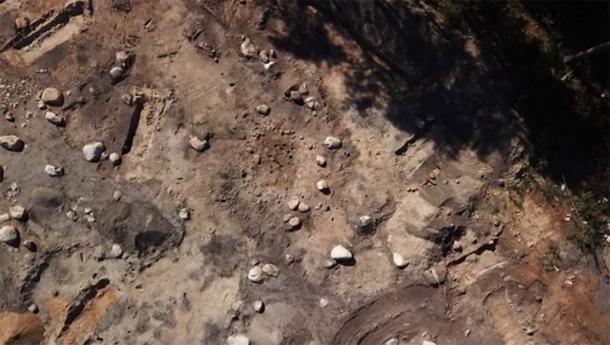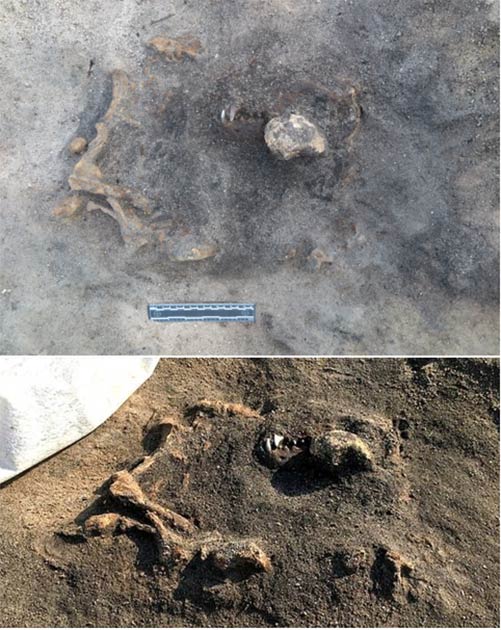Dogs have long been considered to be human’s best friend with evidence of their relationship going back for millennia. Now a remarkable discovery in Sweden, shows that even 8,400 years ago people and dogs had a really special bond. Archaeologists have found canine remains which are not only the oldest ever found in the region but incorporate similar burial rites as would be expected with a human burial. It seems to indicate that the ancient relationship between the Stone Age humans and this dog was more than simply a pragmatic one, but the dog was somehow held in a high regard. The find is providing more information on ancient attitudes and traditions, helping experts to understand our distant ancestors.
Important Stone Age Site of Ljungaviken
Since 2015 archaeologists from Blekinge Museum have been, excavating a site in Ljungaviken in Sölvesborg, Sweden. The experts have found at least 51 structures at what they believe was a coastal settlement that dates to the Stone Age ( Mesolithic). Their digs have revealed pits, hearths and postholes.
The project is the largest archaeological project ever conducted in this part of the country. In the Blekinge Museum report , Carl Persson of the Blekinge Museum explains that “a sudden and violent increase of the sea level flooded the area with mud” and this helped preserve this archaeologically important area.

Part of the excavations at the site where the dog burial was found ( YouTube Screenshot /Arkeologi Ljungaviken)
A Thoughtful Dog Burial
Archaeologists have been removing layer upon layer of sand and mud to reveal the story of a Stone Age community. During this, they came across the remains of a dog, which had been buried in a grave over 8,000 years ago. Ola Magnell of the Blekinge Museum commented that, “The dog is well preserved, and the fact that it is buried in the middle of the Stone Age settlement is unique”.
What fascinated the team was the fact the dog “was buried like a person, noting that survivors often leave valuable or sentimental objects with the dead” reported The Local . The dog’s burial included grave goods, something which is common burial practice in many ancient societies for humans but less common for dogs. The exact nature of the grave goods remains a mystery, as they are contained in the mud surrounding the dog and are yet to be extracted, but include shards of flint.
The finding of dog burials of a complex nature like this is unusual but not unprecedented. Ancient Origins reported on a study of ancient dog burials by Robert Losey in 2016 covering a variety of different dog burials ranging in age from 8000 to 5000 years old. In it Losey said of some of the burials:
“The dogs were being treated just like people when they died. They were being carefully placed in the grave. Some of them were wearing necklaces when they were buried, … they placed spoons and other offerings in the grave with the dog. The idea, I think, being they had souls and an afterlife.”
An animal osteologist has studied the remains in the recently found grave in Sweden. The bones were not similar to modern dog breeds and the Daily Mail reports that the ancient dog was ‘like a powerful greyhound’.
Archaeologists have not removed the remains, but it is expected that they will be carefully extracted and taken to the Blekinge Museum, where they will undergo a range of tests. Removing the remains of the ancient dog will be a painstaking procedure.

The remains of the dog are still at the site, partially excavated. (Carl Persson/ Blekinge Museum )
The bond between ancient humans and dogs
Carl Persson said of the discovery, “A find like this makes you feel even closer to the people who lived here,” and also considers it to indicate that modern people are very similar in certain ways to our ancient forbears.
“A buried dog somehow shows how similar we are over the millennia when it comes to the feelings like grief and loss” Persson said.
The Mystery of Dog Domestication
Around the world, dogs have been found in ancient burials. Dogs were not only used for hunting and security, but it appears that humans developed emotional attachments with canines.
A recent find of two sets of canine remains in Italy , from at least 14,000 years ago, made by a team from the University of Siena, is also helping experts to understand the relationship. Dr Boschin of the University of Siena says of the find in Italy that ‘further analysis which is still ongoing shows this figure could indeed be much later, towards 20,000 years’. Therefore, the find dates to the beginning of the unique relationship between humans and canines.
The recent Italian and Swedish finds can help us to better understand the history of dogs in Europe , indicating at least how long the relationship has existed and also that there was more than just a practical, mutually beneficial relationship, but there was some further bond between man and beast.
Dogs were first domesticated between 20,000 to 40,000 years ago, there is a mystery as to how ‘dogs made the change from wild carnivores to loving companions’ reports the Daily Mail . Among the theories, for this complex process, are that wolves scavenged near human settlements and this led them to become domesticated. Then there is the view that wolves and men hunted together and during this, they formed a symbiotic relationship. Over time, the less aggressive and sociable wolves evolved into something like modern dogs.
The canine remains unearthed at the Sone Age settlement will help experts to better understand the domestication of dogs. They also show evidence for the complex relationship between humans and dogs in ancient Sweden. Work is continuing at the archaeological site until eventually a residential complex will be built at the location.
Top image: Excavation of the site at Ljungaviken, Sweden. Source: Carl Persson/ Blekinge Museum
By Ed Whelan
 RSS Feed
RSS Feed















 September 26th, 2020
September 26th, 2020  Awake Goy
Awake Goy  Posted in
Posted in  Tags:
Tags: 













